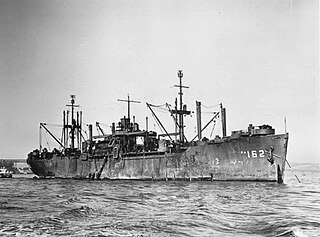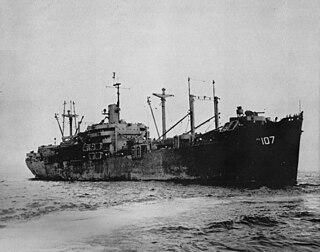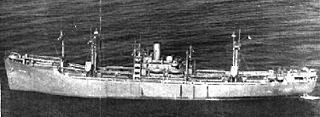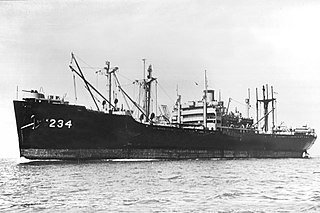
USS Pitt (APA-223/LPA-223) was a Haskell-class attack transport in service with the United States Navy from 1944 to 1947. She was scrapped in 1980.

USS Grumium (AK-112/IX-174/AVS-3) was a Crater-class cargo ship and aviation supply ship in the service of the US Navy in World War II. Named after the star Grumium in the constellation Draco, it was the only ship of the Navy to bear this name.

USS Salem (CM-11) was a commercial cargo ship, that served as a minelayer and then net laying ship of the United States Navy during World War II.

USS Chandeleur (AV-10), a seaplane tender, was launched on 29 November 1941 by Western Pipe and Steel Company, San Francisco, California, under a Maritime Commission contract; transferred to the U.S. Navy 19 November 1942; and commissioned the same day.

USS Chilton (APA-38) was a Bayfield-class attack transport. Her task was to deliver troops to the battle front, and to recover and care for the wounded. She served in the Pacific Ocean in the war against the Empire of Japan and returned home post-war with one battle star to her credit.

USS Alkes (AK-110) was a Crater-class cargo ship commissioned by the US Navy for service in World War II, named after Alkes, a star in the Crater constellation. She was responsible for delivering troops, goods and equipment to locations in the war zone.

USS Matar (AK-119) was a Crater-class cargo ship, converted from a Liberty Ship, commissioned by the US Navy for service in World War II. She was first named after Napoleon B. Broward, an American river pilot, captain, and politician; he was elected as the 19th Governor of the US state of Florida. She was renamed and commissioned after Matar, a binary star in the constellation of Pegasus. She was responsible for delivering troops, goods and equipment to locations in the war zone.

USS Azimech (AK-124) was a Crater-class cargo ship commissioned by the US Navy for service in World War II, named after the Azimech, the other name of Spica, the brightest star in constellation Virgo. She was responsible for delivering troops, goods and equipment to locations in the war zone.

USS Adria (AF-30) was an Adria-class stores ship in service with the United States Navy from 1944 to 1954. She was scrapped in 1977.

USS Drew (APA-162) was a Haskell-class attack transport in service with the United States Navy from 1944 to 1946. She was scrapped in 1974.

USS Eastland (APA-163) was a Haskell-class attack transport in service with the United States Navy from 1944 to 1946 She was scrapped in 1974.

USS Gosper (APA-170) was a Haskell-class attack transport in service with the United States Navy from 1944 to 1946. She was scrapped in 1974.

USS Goodhue (APA-107) was a Bayfield-class attack transport in service with the United States Navy from 1944 to 1946. She was sold into commercial service in 1947 and was scrapped in 1982.

USS Natrona (APA-214) was a Haskell-class attack transport of the US Navy in World War II. She was of the VC2-S-AP5 Victory ship design type. Natrona was named for Natrona County, Wyoming.

USS Las Vegas Victory (AK-229) was a Boulder Victory-class cargo ship acquired by the U.S. Navy during World War II. She served in the Pacific Ocean theatre of operations through the end of the war earning one battle star, and then returned to the United States for disposal.

USS Manderson Victory (AK-230) was a Boulder Victory-class cargo ship acquired by the U.S. Navy during World War II. She served in the Pacific Ocean theatre of operations through the end of the war, earning one battle star, and then returned to the United States for disposal.
USS Bedford Victory (AK-231) was a Boulder Victory-class cargo ship Victory ship acquired by the U.S. Navy during World War II. She served in the Pacific Ocean theatre of operations through the end of the war, earning one battle star, and then returned to the United States for disposal.
USS Newcastle Victory (AK-233) was a Boulder Victory-class cargo ship acquired by the U.S. Navy during World War II. She served in the Pacific Ocean theatre of operations through the end of the war, and then returned to the United States of America for disposal.

USS Bucyrus Victory (AK-234) was a Boulder Victory-class cargo ship acquired by the U.S. Navy during World War II. She served in the Pacific Ocean theatre of operations through the end of the war, earning one battle star, and then returned to the United States for disposal.

USS Lakewood Victory (AK-236) was a Boulder Victory-class cargo ship acquired by the U.S. Navy during World War II. She served in the Pacific Ocean theatre of operations through the end of the war, earning two battle stars, and then returned to the United States for disposal.


















